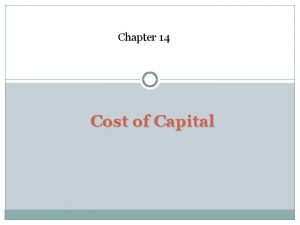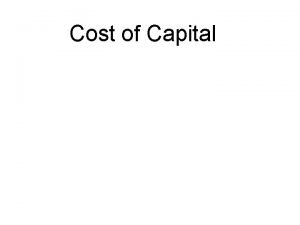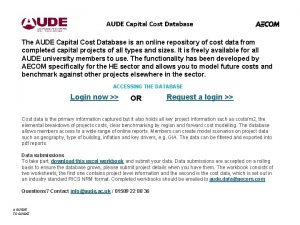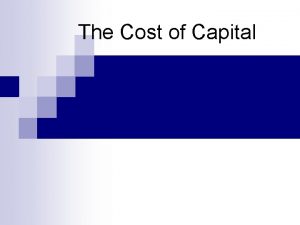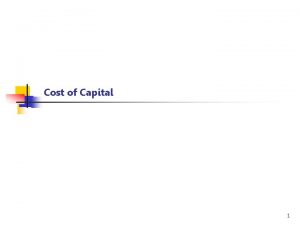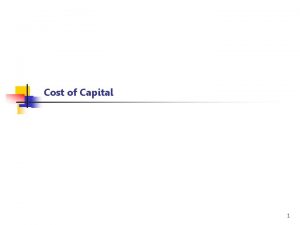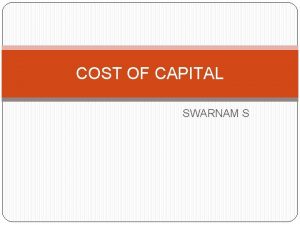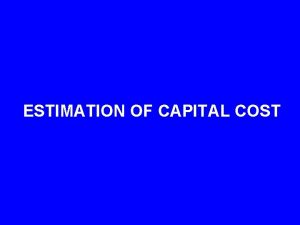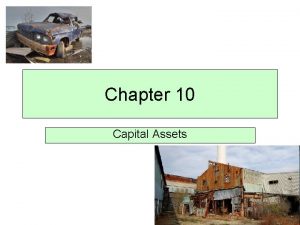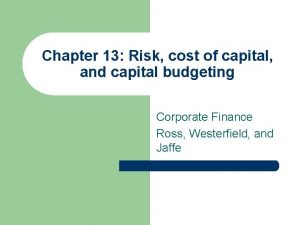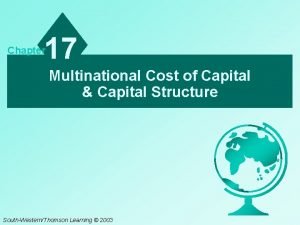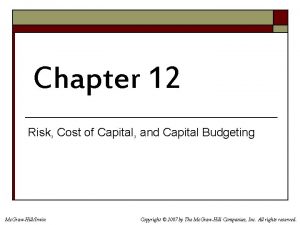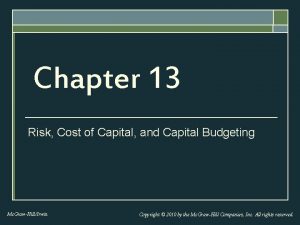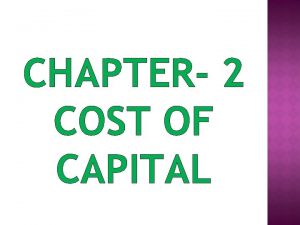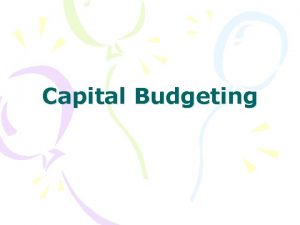The Cost of Capital Chapter 12 Cost of

























- Slides: 25

The Cost of Capital Chapter 12

Cost of Capital u The firm’s average cost of funds, which is the average return required by the firm’s investors u What must be paid to attract funds

The Logic of the Weighted Average Cost of Capital u The use of debt impacts a fim’s ability to use equity, and vice versa, so the weighted average cost must be used to evaluate projects, regardless of the specific financing used to fund a particular project

Basic Definitions u Capital component F types of capital used by firms to raise money F kd = before tax interest cost F kd. T = kd(1 -T) = after tax cost of debt F kps = cost of preferred stock F ks = cost of retained earnings F ke = cost of external equity (new stock)

Basic Definitions u WACC = weighted average cost of capital u Capital structure F combination of different types of capital used by a firm

After-Tax Cost of Debt u The relevant cost of new debt—its yield to maturity (YTM) u Taking into account the tax deductibility of interest u Used to calculate the WACC u kd. T = bondholders’ required rate of return minus tax savings u kd. T = kd - (kd T) = kd(1 -T)

Cost of Preferred Stock u Rate of return investors require on the firm’s preferred stock u the preferred dividend divided by the net issuing price

Cost of Retained Earnings u Rate of return investors require on the firm’s common stock Three solutions: 1. CAPM 2. Bond yield plus risk premium 3. Discounted cash flow (DCF)

The CAPM Approach

The Bond-Yield-Plus. Premium Approach u Estimate a risk premium above the bond interest rate u Judgmental estimate for premium u “Ballpark” figure only

The Discounted Cash Flow (DCF) Approach u Price and expected rate of return on a share of common stock depend on the dividends expected on the stock

DCF Approach u Internal equity, ks F based on the fact that investors demand the firm use funds that are retained to earn an appropriate rate of return

Cost of Newly Issued Common Stock u External equity, ke F based on the cost of retained earnings F adjusted for flotation costs (the expenses of selling new issues)

Target Capital Structure u Optimal capital structure F percentage of debt, preferred stock, and common equity that will maximize the price of the firm’s stock

Weighted Average Cost of Capital, WACC u A weighted average of the component costs of debt, preferred stock, and common equity

Marginal Cost of Capital u MCC F the cost of obtaining another dollar of new capital F the weighted average cost of the last dollar of new capital raised

MCC Schedule u Marginal cost of capital schedule F a graph that relates the firm’s weighted average of each dollar of capital to the total amount of new capital raised F reflects changing costs depending on amounts of capital raised

MCC Schedule u Weighted Average Cost of Capital (WACC) (%) WACC 3=11. 5% 11. 5 - WACC 2=11. 0% 11. 0 10. 5 - WACC 1=10. 5% New Capital Raised (millions of dollars) 100 150

Break Point u BP F the dollar value of new capital that can be raised before an increase in the firm’s weighted average cost of capital occurs

MCC Schedule u Weighted Average Cost of Capital (WACC) (%) WACC 3=11. 5% 11. 5 - WACC 2=11. 0% 11. 0 10. 5 - WACC 1=10. 5% BPRE 100 BPDebt New Capital Raised (millions of dollars) 150

MCC Schedule u Schedule and break points depend on capital structure used

MCC Schedule u Weighted Average Cost of Capital (WACC) (%) Smooth, or Continuous, Marginal Cost of Capital Schedule WACC 0 - Dollars of New Capital Raised

Combining the MCC and Investment Opportunity Schedules u Use the MCC schedule to find the cost of capital for determining whether a project should be purchased u Investment Opportunity Schedule (IOS) F graph of the firm’s investment opportunities ranked in order of the projects’ rates of return

Combining the MCC and Investment Opportunity Schedules Percent 12. 0 - Return. C = 12. 0% Return. B = 11. 6% Return. D = 11. 5% 11. 5 - Return. E = 11. 3% WACC 2=11. 0% 11. 0 10. 5 - WACC 3=11. 5% MCC IRRA = 10. 8% WACC 1=10. 5% IOS Optimal Capital Budget - $139 20 40 60 80 100 120 140 160 180 New Capital Raised and invested (millions of dollars)

End of Chapter 12 The Cost of Capital
 Multinational capital structure
Multinational capital structure Multinational cost of capital and capital structure
Multinational cost of capital and capital structure Chapter 14 cost of capital
Chapter 14 cost of capital Net working capital refers to
Net working capital refers to Difference between capital reserve and reserve capital
Difference between capital reserve and reserve capital Difference between capital reserve and reserve capital
Difference between capital reserve and reserve capital Basle ii
Basle ii Regulatory capital vs economic capital
Regulatory capital vs economic capital Variable capital examples
Variable capital examples Capital allocation line vs capital market line
Capital allocation line vs capital market line Hình ảnh bộ gõ cơ thể búng tay
Hình ảnh bộ gõ cơ thể búng tay Ng-html
Ng-html Bổ thể
Bổ thể Tỉ lệ cơ thể trẻ em
Tỉ lệ cơ thể trẻ em Chó sói
Chó sói Tư thế worms-breton
Tư thế worms-breton Chúa yêu trần thế alleluia
Chúa yêu trần thế alleluia Các môn thể thao bắt đầu bằng tiếng đua
Các môn thể thao bắt đầu bằng tiếng đua Thế nào là hệ số cao nhất
Thế nào là hệ số cao nhất Các châu lục và đại dương trên thế giới
Các châu lục và đại dương trên thế giới Công thức tính độ biến thiên đông lượng
Công thức tính độ biến thiên đông lượng Trời xanh đây là của chúng ta thể thơ
Trời xanh đây là của chúng ta thể thơ Cách giải mật thư tọa độ
Cách giải mật thư tọa độ Phép trừ bù
Phép trừ bù độ dài liên kết
độ dài liên kết Các châu lục và đại dương trên thế giới
Các châu lục và đại dương trên thế giới


